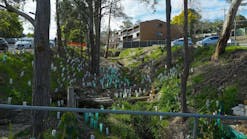About the author: Will Mahoney, P.G., CPSWQ, is a senior environmental scientist and ambassador for the SOIL Fund. Mahoney can be reached at [email protected] or 303.968.0663.
In 2008, the International Erosion Control Assn. (IECA) launched a charitable arm, the Save Our International Land (SOIL) Fund. The vision of the fund’s participants and supporters is to expand the science of erosion and sediment control and improve the lives of those impacted by erosion and sedimentation. The fund’s mission is to provide technical assistance for programs and projects that address soil erosion and sedimentation through applied technology, education and research.
Most of the fund’s projects have taken place in developing countries. A key component of the fund’s approach has been the concept of sustainability: Erosion control in remote areas of developing countries works best when it relies on local materials, simple technology and equipment, and involvement of community members. Application of the sustainability principle can be illustrated by looking at three projects.
Easter Island in the South Pacific became impoverished from centuries of deforestation. Pablo Garcia-Chevasich (an Arizona IECA member) received SOIL Fund support for a reforestation demonstration project on the island using banana trees. Infiltration trenches were excavated at the selected site using a locally available tractor. The trenches facilitate root development and capture rainwater runoff on the moderately sloping hillside. Holes for each tree were excavated by hand within the trenches. A simple rooftop rainwater harvesting system was installed. This system provides a steady supply of water to the young trees and enables local families to grow vegetables between tree rows, increasing their monthly incomes and maximizing use of previously unproductive land.
In 2011, the SOIL Fund sent me to a community in the Andes Mountains of Ecuador. I identified more than 40 sites that were seriously eroded. Since 2012, teams from Engineers Without Borders (EWB) have worked with the community to stabilize several of the high-priority sites. The community has learned simple construction techniques that can be performed with hand tools, as well as how to use local materials such as cobbles for check dams and plants (native trees, shrubs and grasses) for soil stabilization. The EWB teams have avoided creating a dependency on foreign advisers and imported materials. As a result, the community now is continuing erosion control work on its own, and neighboring villages are asking for its assistance.
This year, the SOIL Fund supported a proposal from Elise Pinners, a Kenya-based IECA member. Pinners’ Kenyan colleague, Jane Wegesa, traveled to a peaceful area in newly independent South Sudan with a truckload of vetiver, a hearty tropical plant with a deep root system. When planted in rows, vetiver provides a barrier against topsoil loss. Wegesa showed students and teachers at a girls’ school how to establish a nursery for the vetiver and use it to stabilize gullies. The girls now are providing vetiver cuttings to their parents and neighbors and showing them how to use these plants to prevent erosion in their vegetable gardens and cropland. Although the vetiver initially had to be imported from neighboring Kenya, the nursery now will provide a long-term supply of plants to the community.
Download: Here





